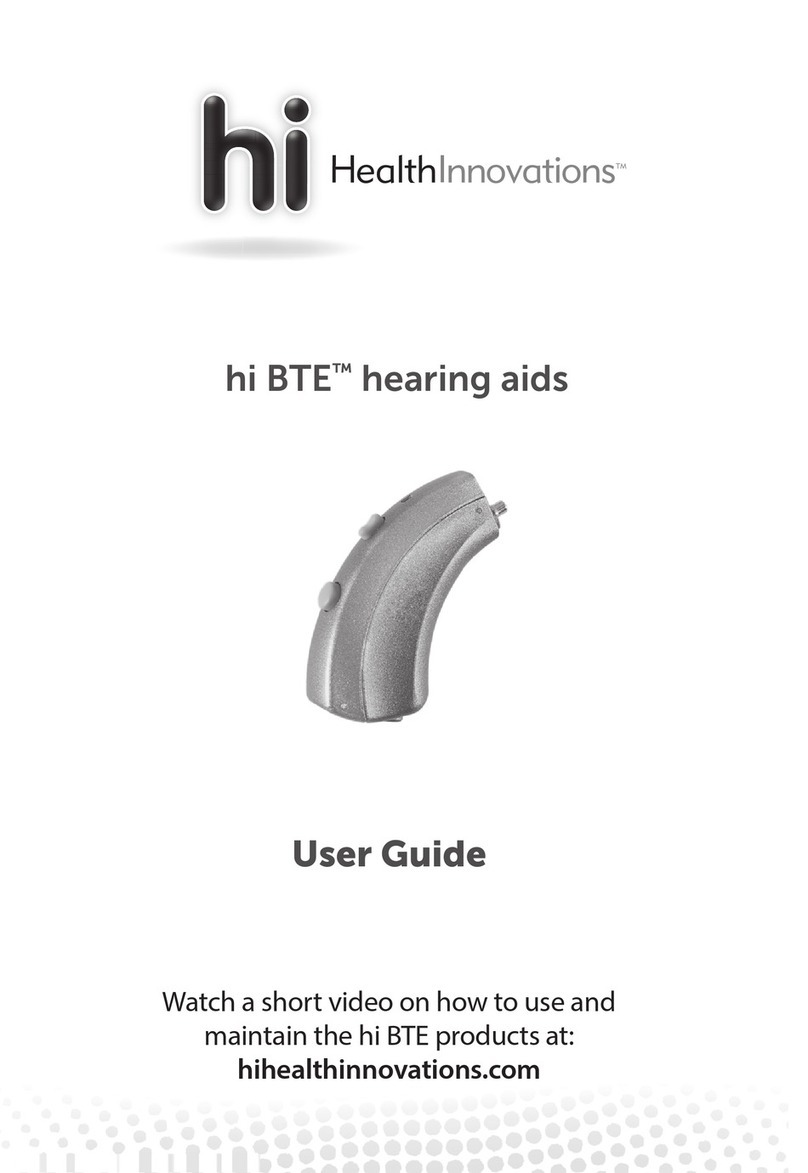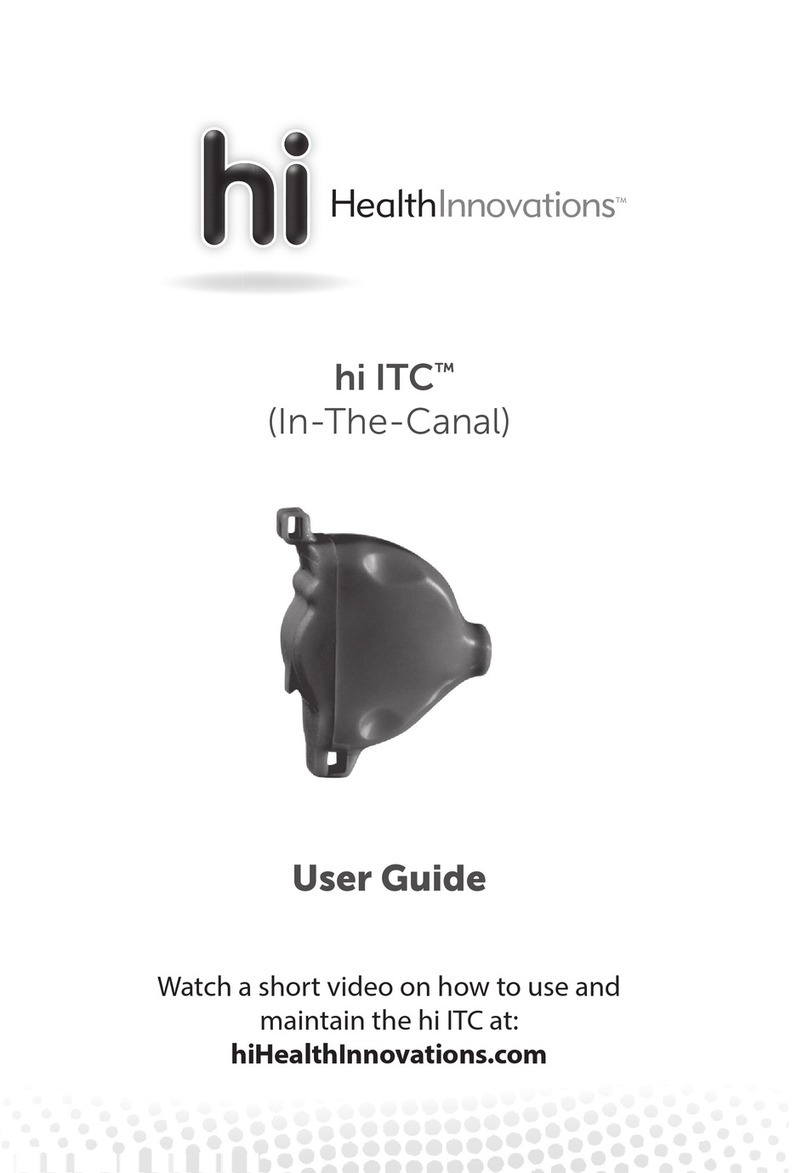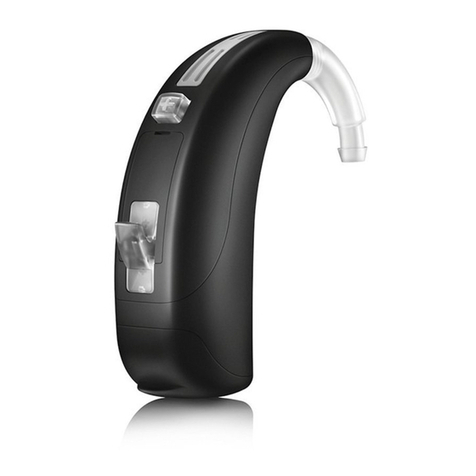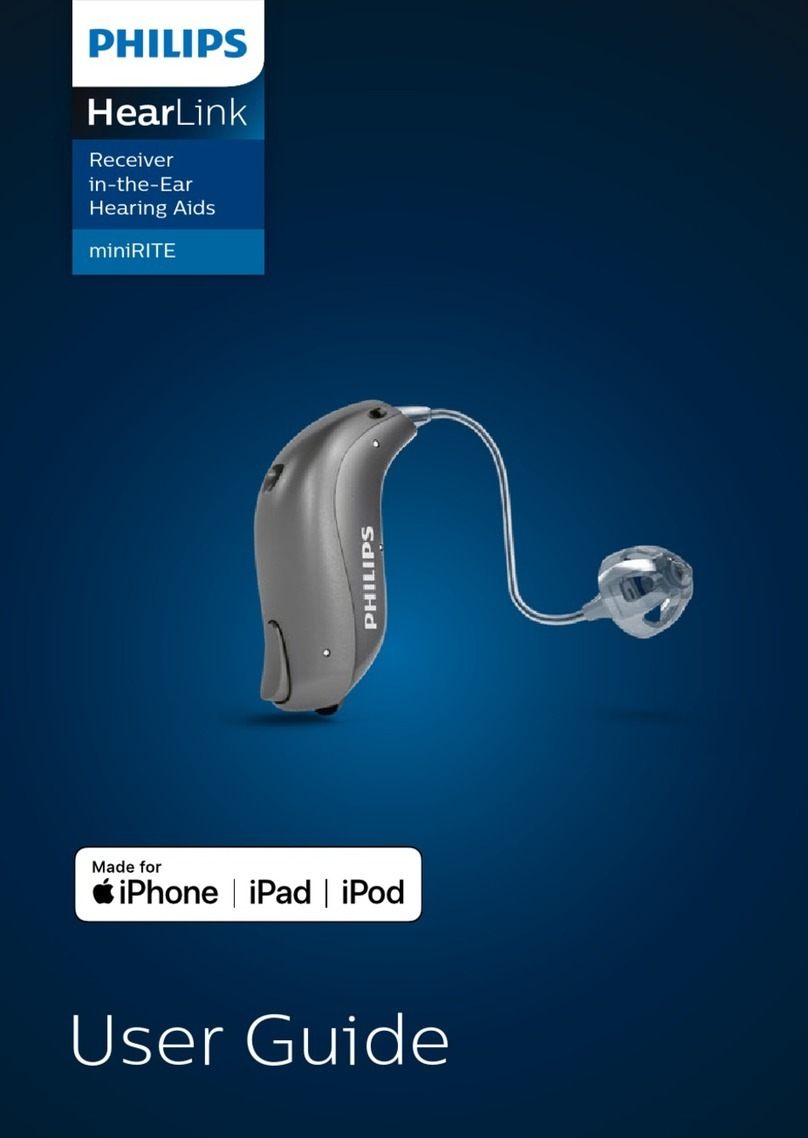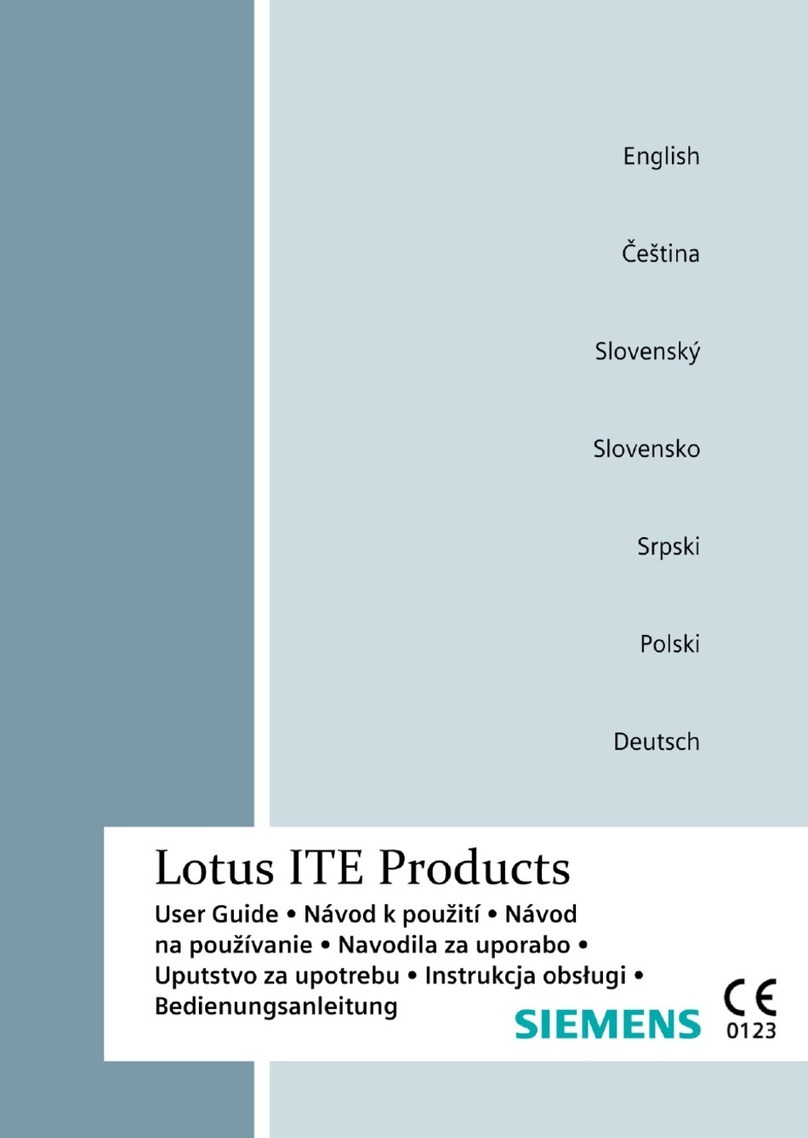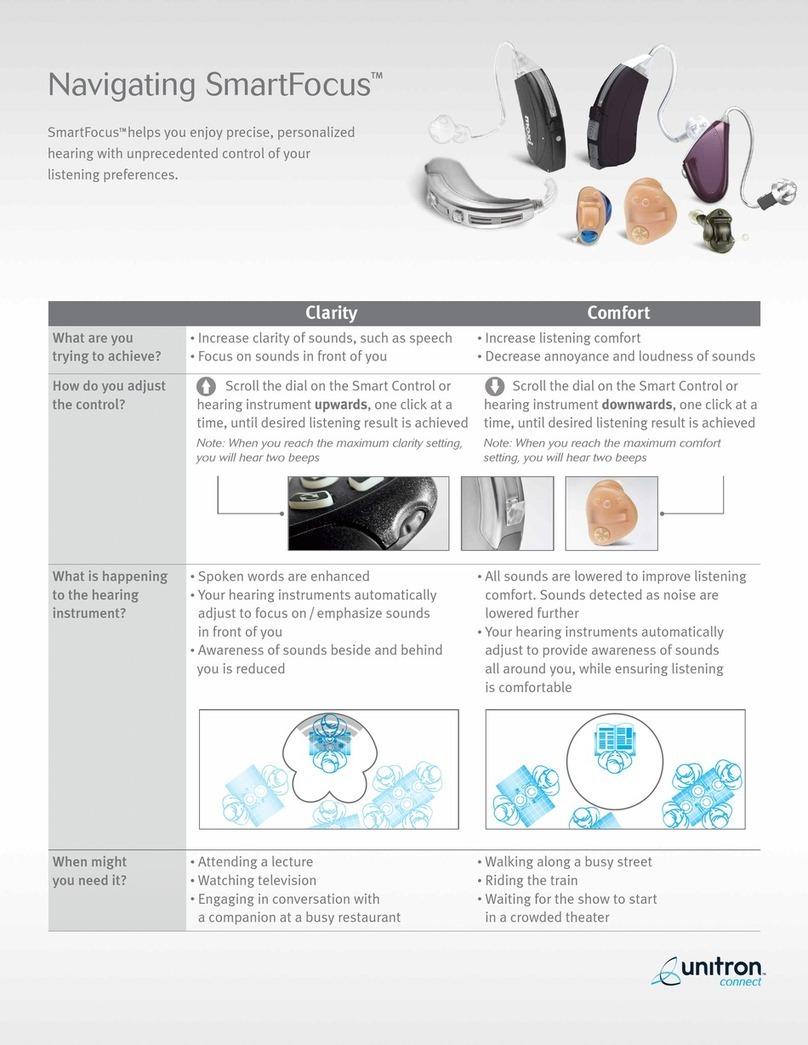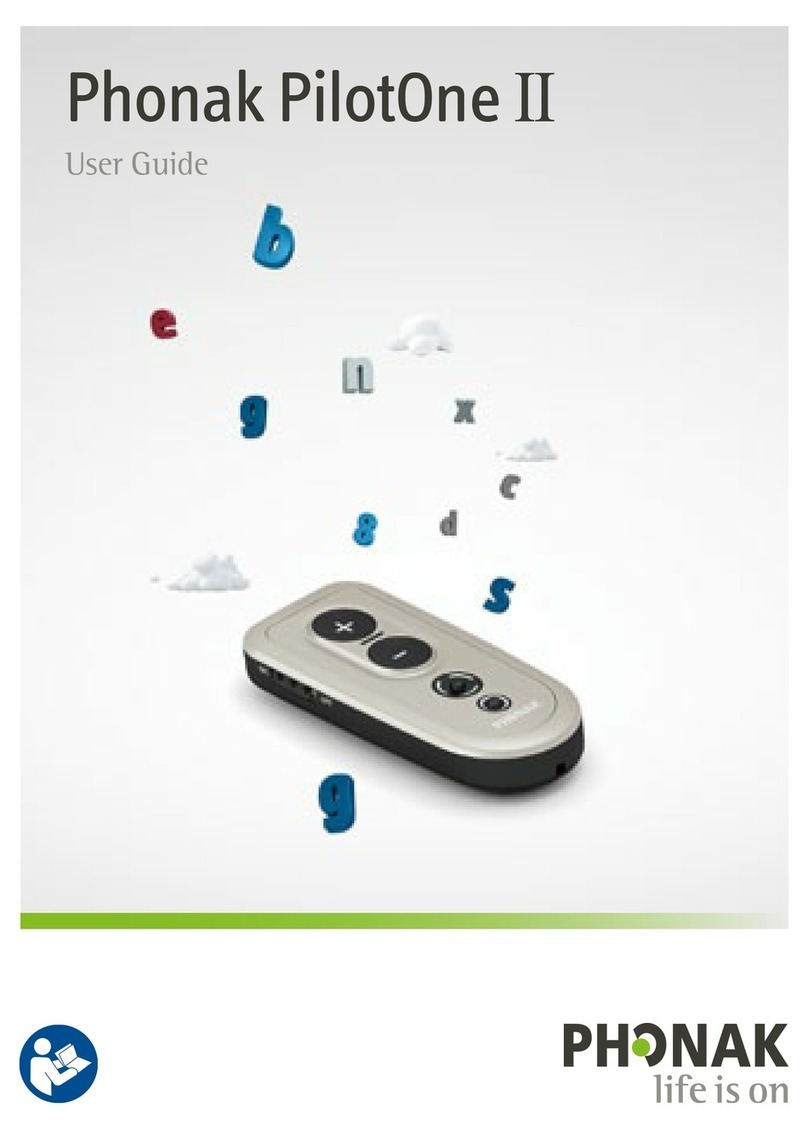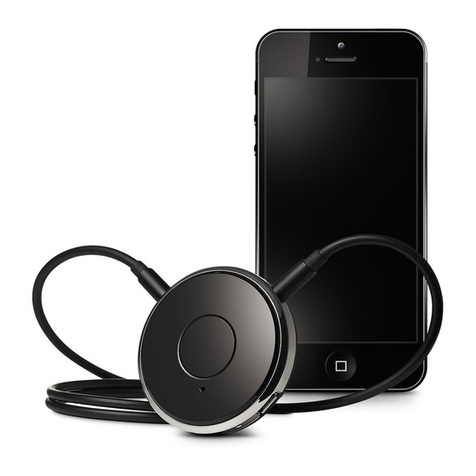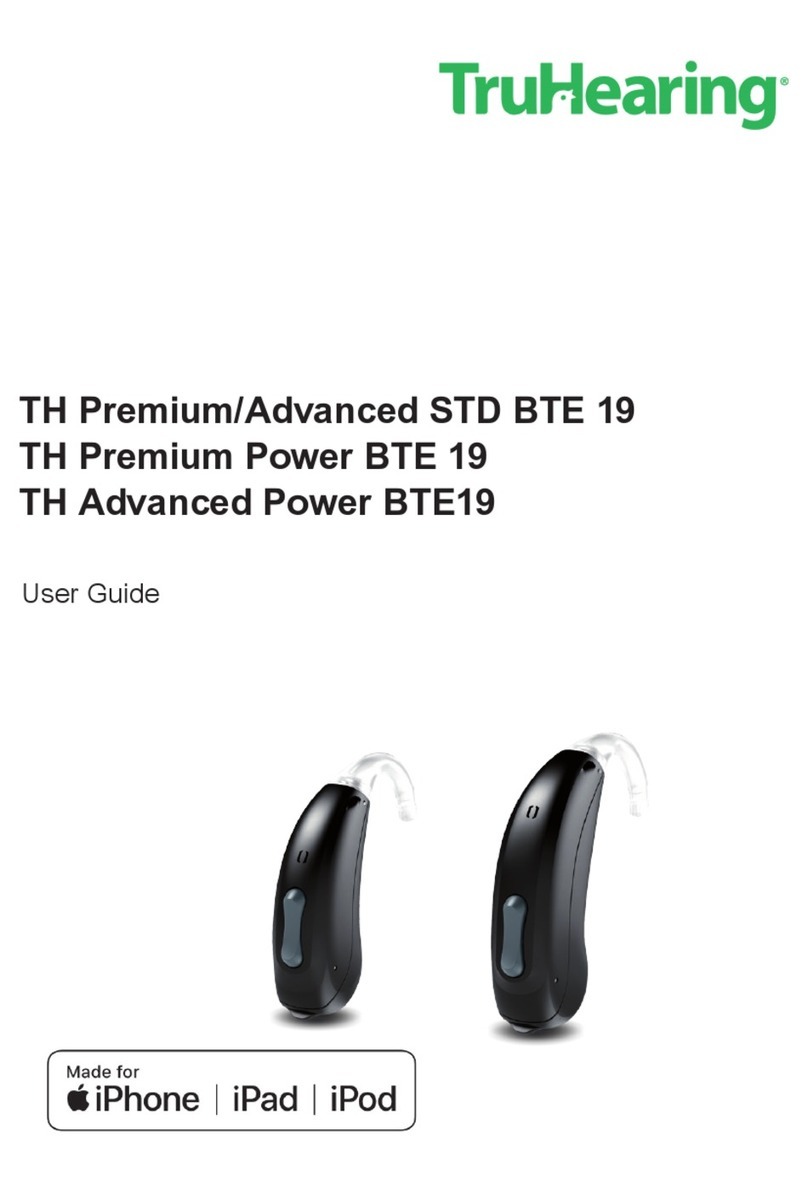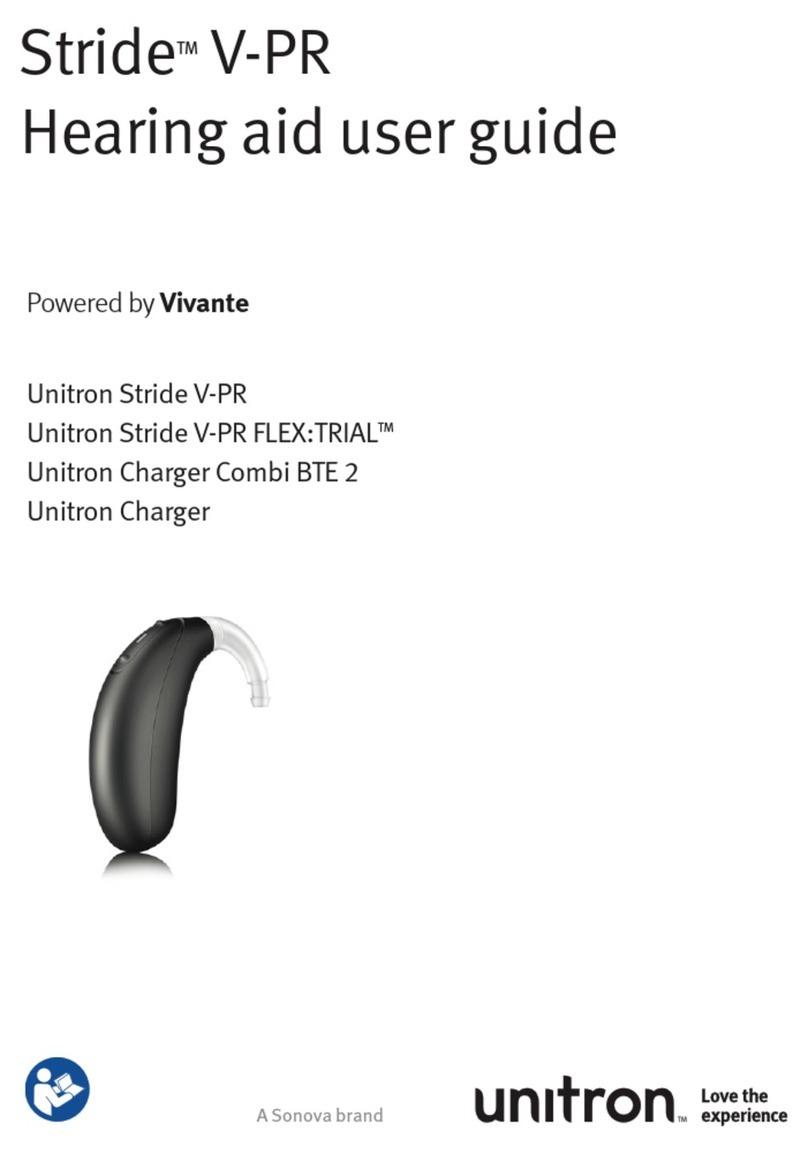hi Health Innavations hi BTE mini User manual

hi BTE mini™
(Behind-The-Ear)
User Guide
Watch a short video on how to use and
maintain the hi BTE mini at:
hiHealthInnovations.com

Getting the most from your
new hearing aids ...........................2–3
hi BTE mini ..................................... 4
Turning your hearing aids on and o ............ 5
Wearing your hearing aids ................... 5–6
Maintaining your hearing aids .................7–9
Battery .....................................10–12
Changing program and volume settings .....13–14
Using with telephones and cellular phones ..... 15
Caring for your hearing aids .................16–17
Troubleshooting ............................... 18
Technical specications .....................19–20
Warranty, return and service.................... 21
FDA statements ............................22–23
Top 3 tips ..................................24–25
Table of contents

2 3
•Wheneverpossible,directlyfacethesoundsyou
are trying to hear and move closer, especially
in noisy environments. When speaking with
someone, you can also use facial cues to help
you understand. If you would like information
on speech (lip)-reading or additional help,
consider nding a support group. A good
place to start is the Hearing Loss Association of
America (HLAA) at hearingloss.org
•Yourownvoicemayinitiallysoundloud,oras
though you are talking “in a barrel.” This is very
common, and most people get used to it overtime
•Ifyouarenewtohearingaids,youmayhear
background noise (e.g., hum of a fan) that
you may not have heard in a long time. Most
people are able to tune out these noises as they
continue to wear their hearing aids
•Whenyouareinarestaurant,avoidsittinginthe
middle of the room or near the kitchen. A booth
to the side or in a corner will be more favorable
•Itisnotnecessarytoremoveyourhearingaids
at security checkpoints (e.g., airports). However,
you should remove your hearing aids for CT
and MRI scans or for other electromagnetic
procedures
Getting the most from your new hearing aids
Hearing is a vital part of how you connect with the
world, from laughing at a punch line to sharing
a secret with a loved one. Hearing is also vital to
your overall health. Untreated hearing loss can
contribute to depression, anxiety and dementia.
Congratulations on taking control of your
hearinghealth!
While no hearing aid can restore normal hearing and
will not prevent or improve a hearing impairment
resulting from organic conditions, these tips will help
you obtain the most benets from your hearing aids:
•Ifyouarenewtohearingaids,itmaytakeafew
weeks before you are completely comfortable
with them and can fully enjoy the benets. Be
patient as you adjust to hearing sounds that you
may not have heard in a long time. If you need
to, start by wearing your hearing aids a few hours
a day and gradually extend the period of time.
Infrequent use of hearing aids does not provide
full benets, so your ultimate goal is to wear the
hearing aids all day, every day
•Youmayndthataquietenvironmentismore
comfortable at rst. Gradually introduce new
listening environments

4 5
Yourhearingaidhasabatterydoorthatactsas
an on/o switch and allows access to thebattery.
When the door is closed, the hearing aid is on.
When the door is open, the hearing aid is o.
1. ON: Simply close the battery door with a battery
in it.
2. OFF: When you’re not wearing your hearing aids,
keep the battery door open to extend battery life.
Youdonotneedtoremovethebattery.Fully
opening the battery door allows any moisture
to evaporate, which keeps the hearing aids
working well.
Wearing your hearing aids
Place your hi BTE mini over the top of your ear until
it rests securely behind your ear.
Turning your hearing aids on and ohi BTE mini
1. Microphone and
speaker – Sound
enters the hearing
aid through the
microphone. The
speaker delivers
amplied sound to
you.
2. Push button –
Switches between
listening programs and/or volume levels.
3. Battery door / on and o – Close the door to
turn on the hearing aid. Open the door to turn
o thehearing aid. Do not touch the push
button when you open or close the door.
Left/Right – Inside the battery door is a blue “+”
sign indicating the hearing aid is for the left ear,
or a red “+” sign indicating the right ear.
4. Serial number – Each hearing aid has a unique
serialnumber.
5. Ear tube & tip – Each hearing aid comes with an
ear tube & tip that connects to the hearing aid
speaker. Sound travels through the ear tube &
tip to yourear.
6. Retention loop – helps keep the ear tube & tip
inplace.

6 7
While holding the
hearing aid in place,
insert the ear tip into
your ear canal, and curl/
tuck the retention loop
along the body of your
ear. This retention loop
will eventually tuck in
easily, as body heat helps
it conform to the shape of your ear.
The ear tip should be completely or almost
completely in the ear canal. Use your ngernail to
push the tube (rather than the ear tip) into the ear
canal. This will help the ear tip to go deeper. Your
goal is to go as deep as possible without touching
your ear drum. Proper insertion of the ear tip is key
to getting enough loudness and avoid whistling.
If you wear eyeglasses, put your glasses on rst and
then put your hearing aid on.
Allergic reactions to hearing aids are unlikely.
However, if you experience skin irritation, redness,
or soreness in or around your ears, please contact
your physician.
Maintaining your hearing aids
Replacing ear tube & tip
Youreartube&tipwillcomeconnectedupon
shipment. For optimal performance, replace ear
tube & tip every threemonths.
Removing ear tube & tip from hearing aid:Grasp
the “hearing aid end” of the ear tube; gently turn ~90
degrees and pull to remove the ear tube from the
hearing aid.
Note: Do not bend the ear tube & tip back and
forth to remove it.
Attaching ear tube & tip to hearing aid: Gently
push the “hearing aid end” of the ear tube onto the
hearing aid until it snaps into position.
1) Turn ~90
degrees
2) Pull the
“hearing aid
end” of ear
tube

8 9
Cleaning ear tube & tip
Between replacements, you’ll need to clean the ear
tube & tip with a cleaning wire, at least once aweek.
Remove the ear tube & tip from the hearing aid.
Thread the cleaning wire through the ear tube,
starting at the “hearing aid end,” until it comes out
at the “ear tip end.” Pull the cleaning wire all the
way through. Be sure to wipe o the wire before
the next cleaning.
Clean the ear tip with a dry cloth.
Note: Ensure the wire goes through the ear tube in
only one direction, from “hearing aid end” to “ear
tip end.” Do not reverse the wire back through the
eartube.
“ear tip end”
“hearing aid
end”
Cleaning ear tubes with a double-dome tip
If you have an ear tube with a double-dome tip, you
will need to remove the double-dome to clean it.
Carefully pull the double-dome tip o the tube.
Clean the tube in the manner as described on the
previous page.
Push the double dome back onto the tube. Ensure
the double-dome tip is attached to the tube, but
isnottoofaronit.Youwillknowitistoofarifthe
double dome tip is at on top.
Too far*
(flat on top)
Correct
(rounded on top)
*Flatness is due to the tube decompressing the
vent on the double dome tip. This will reduce the
volume of the sound.

10 11
Battery
The hi BTE mini uses a size 10 battery. The battery
life varies, depending on the amount of hearing aid
use, but is typically about 7 days. Please insert a
battery when you receive the hearing aid.
Low battery indicator
A warning of three double beeps every eight
minutes indicates that the battery needs to be
replaced. If you do not change your battery, you will
hear another warning of six double beeps, at which
time your hearing aid will automatically turn o.
Battery warning information
Dispose of used batteries in an environmentally
friendly way. Do not place batteries in your mouth.
If swallowed, contact your physician immediately
or call the National Battery Hotline at
1-202-625-3333.
Inserting/replacing the battery
1. Grasp the sides of the hearing aid and gently
pull open the battery door. (Do not touch the
push button when you open or close the
door.) Remove the battery.
2. Using the plastic tab of a fresh battery, place the
battery into the battery door with the tab facing
up. Hold the battery in place, and peel o the tab.
Insert battery
into battery
door.
Battery
correctly
placed in
the battery
door.

12 13
3. To fully activate the battery, wait for a minute,
then gently close the battery door. If it doesn’t
close easily, check to see if the battery was
inserted properly.
Note: When the battery is taken out and put back
in, the hearing aid returns to the last program
you were in.
If you have worn hearing aids before, you may
have used dierent programs for dierent
environments. Our hearing aids automatically
adjust to dierent environments. Thus, once you
determine your preferred program, you can leave
it in that setting.
Program control
YourhiBTEminifeaturesapushbuttonthat
allows you to choose between three program
settings. Spend time using each of the programs
to determine which one you like best. Use that
program the majority of the time. Within each
program, you can use the volume control to make
sounds louder or softer as you wish.
Simply press and hold the push button for
two seconds to change the program setting.
The hearing aid will beep to let you know which
program has beenselected. Please keep your ear
tip in your ear to hear the beep(s).
Program 1 ♪ 1 beep
Program 2 ♪♪ 2 beeps
Program 3 ♪♪♪ 3 beeps
Changing program and volume settings

14 15
Volume control
The push button on the hi BTE mini also allows you
to choose between ve volume levels. Press and
quickly release the button to change the volume.
Youwillhearonebeepwhenyoureachthe
maximum volume. If you press and release again,
you will loop back to the lowest volume.
*After 5, the hearing aid loops back to volume 1
5* Maximum volume = beep
3
4
2
Volume levels
1
It is normal to have whistling when you hold the
hearing aid in your hand, or when you place your
hand over your ear. However, once the ear tips
are all the way in the ear canal (please see page 6),
you should be able to wear your hearing aids at
a comfortable volume without whistling. If your
hearing aid whistles, change to program 1 and/or
turn the volume down.
Using with telephones and cellular phones
Traditional corded phones, cordless phones
and cell phones:
First, try to use the phone as you normally would
hold it. If you cannot hear well, move the handset
up slightly to nd the position that sounds best
to you. If you encounter whistling, tilt the phone
handset at an angle until the whistling stops. It
may help to turn the volume up on your phone.
Practice using the telephone with someone familiar
to you, and move the phone around a bit to get the
best sound.

16 17
Caring for your hearing aids
Regardless of how much you paid for hearing aids,
they are sensitive electronic devices susceptible
to moisture and wax. Do your best to keep your
hearing aids clean and dry at all times. For more
information, watch the hi BTE mini video at
hiHealthInnovations.com
•WhennotwearingyourhiBTEminis,openthe
battery door to allow any moisture to evaporate.
This also helps extend battery life. Store your
hearing aids in a safe, dry place, away from
direct sunlight and avoid extremetemperatures
•Donotleaveyourhearingaidsinthebathroom
while showering
•Whenyousweat,besuretotakeyourhearing
aids o and allow them to dry for a minimum of
15 minutes before putting them back on
•Earwaxisnaturalandcommon,butitcancause
your hearing aids to feedback or malfunction. It
is important to follow the cleaning instructions
for the ear tube & tip on page 8-9
•Donotusewater,alcoholorotherliquidagents
to clean the hearing aid as it may damage them.
If the hearing aids become wet, do not attempt
to dry them in an oven or microwave. Open the
battery door, remove the battery and let the
hearing aid dry naturally for 24-48 hours
•Ifyouliveinahumidclimateorarearound
persistent moisture, consider purchasing a low
cost hearing aid dehumidier or dryer. We have
hearing aid dryers available for purchase
•Askyourdoctortoremoveexcessiveear
wax from your ears, or ask if you can use an
over-the-counter kit to remove ear wax
•Removeyourhearingaidsbeforeusinghair
spray, spray perfume or shaving lotions, as these
items can clog or damage your hearing aids
•Donotdropyourhearingaidsorknockthem
against hard surfaces

18 19
Troubleshooting
Cause Possible remedy
1. No sound or not loud enough
Not turned on Turn on by closing the
battery door
Low/dead battery Replace battery
Ear wax Clean/replace ear tube&tip
Programming
adjustment
Contact Customer Service
Moisture Open battery door and
allow to dry
2. Three double beeps
Low battery Replace battery
3. Whistling or feedback
Ear tips not
inserted properly
Remove and reinsert
Hair or clothing
near ear
Remove hair or clothing
near ear
Check for cracks
in ear tube
Replace ear tube & tip
4. Poor t
Ear tip falling out
of your ears
Contact Customer Service
Technical specifications
Technical data elements
•PeakOSPL90118dBSPL
•HFAOSPL90109dBSPL
•Averagefull-ongain34dB
•Peakgain40dB
•Referencetestgain32dB
•Frequencyrange200–5500Hz
•Totalharmonicdistortion<2%
•Equivalentinputnoise<34dBSPL
•Batterycurrentdrain0.80mA
•Attack6mSandrelease30mS

20 21
300
Saturation output curve
Frequency response curve
Input/Output
OSL90
FRC response
Input-output curve
Warranty
Each hearing aid comes with a one-year manufacturer’s
warranty from the date of shipment to you. If at our
examination it is determined that the unit failed to work due
to parts, materials or workmanship, the hearing aid will be
repaired or replaced for free. This warranty does not cover
malfunctions due to unusual wear and tear, unauthorized
alteration or mistreatment of the hearing aid, such as physical
shock, damage from moisture or sweat, excessive wax
build-up, or tampering with the instrument, all of which void
the warranty. This warranty does not cover batteries, ear
tubes & tips, or accessories. hiHealthInnovations is the only
authorized service center for your warranty service. Please
contact Customer Service at 1-855-523-9355 to obtain a return
authorization code and a shipping label.
Cancellation and return information
To cancel your purchase, you must give or mail written
notice of cancellation to us. Please see the enclosed Bill of
Sale for complete details about the refund policy, visit
hiHealthInnovations.com or contact Customer
Service at 1-855-523-9355.
Service
Our mailing address is P.O. Box 356, Minneapolis, MN55440.
Please do not mail to this address without contacting
Customer Service rst at 1-855-523-9355.
Warranty, return and service

22 23
FDA statements
Warning to hearing aid dispensers. A hearing aid dispenser
should advise a prospective hearing aid user to consult
promptly with a licensed physician (preferably an ear specialist)
before dispensing a hearing aid if the hearing aid dispenser
determines through inquiry, actual observation, or review of any
other available information concerning the prospective user,
that the prospective user has any of the following conditions: (i)
Visible congenital or traumatic deformity of the ear; (ii) History
of active drainage from the ear within the previous 90 days; (iii)
History of sudden or rapidly progressive hearing loss within the
previous 90 days; (iv) Acute or chronic dizziness; (v) Unilateral
hearing loss of sudden or recent onset within the previous 90
days; (vi)Audiometric air-bone gap equal to or greater than 15
decibels at 500hertz(Hz), 1,000 Hz, and 2,000 Hz; (vii) Visible
evidence of signicant cerumen accumulation or a foreign body
in the ear canal; (viii) Pain or discomfort in theear.
Important notice for prospective hearing
aid users
Good health practice requires that a person with hearing loss
have a medical evaluation by a licensed physician (preferably
a physician who specializes in diseases of the ear) before
purchasing a hearing aid. Licensed physicians who specialize
in diseases of the ear are often referred to as otolaryngologists,
otologists or otorhinolaryngologists. The purpose of medical
evaluation is to assure that all medically treatable conditions
that may aect hearing are identied and treated before the
hearing aid is purchased.
Following the medical evaluation, the physician will give you
a written statement that states that your hearing loss has
been medically evaluated and that you may be considered a
candidate for a hearing aid. The physician will refer you to an
audiologist or a hearing aid dispenser, as appropriate, for a
hearing aid evaluation.
The audiologist or hearing aid dispenser will conduct a
hearing aid evaluation to assess your ability to hear with and
without a hearing aid. The hearing aid evaluation will enable
the audiologist or dispenser to select and t a hearing aid to
your individual needs.
If you have reservations about your ability to adapt to
amplication, you should inquire about the availability of a
trial-rental or purchase-option program. Many hearing aid
dispensers now oer programs that permit you to wear a
hearing aid for a period of time for a nominal fee, after which
you may decide if you want to purchase the hearing aid.
Federal law restricts the sale of hearing aids to those
individuals who have obtained a medical evaluation from a
licensed physician. Federal law permits a fully informed adult
to sign a waiver statement declining the medical evaluation
for religious or personal beliefs that preclude consultation
with a physician. The exercise of such a waiver is not in your
best health interest and its use is strongly discouraged.
Children with hearing loss
In addition to seeing a physician for a medical evaluation, a
child with hearing loss should be directed to an audiologist
for evaluation and rehabilitation since hearing loss may cause
problems in language development and the educational and
social growth of a child. An audiologist is qualied by training
and experience to assist in the evaluation and rehabilitation
of a child with hearing loss.

24 25
Top 3 Tips
1. Call in to a free user seminar with a
hi HealthInnovations hearing specialist
(see back cover).
2. Visit hihealthinnovations.com and watch the
hi BTE mini video.
3. Take special note of instructions on
• Communicationstips(page2-3).Wear your
hearing aids as much as possible to help your
brain adjust. Successful hearing aid users will tell
you that the benet of wearing hearing aids is
much greater than the eort it may take to adjust
to them. Directly face the sounds you are trying
to hear and move closer, especially in a noisy
environment. To hear better in noisy environments,
we strongly recommend that you wear a hearing
aid on each ear.
• Caringforyourhearingaids(page5,7-9).When
not wearing your hearing aids, open the battery
door to allow any moisture to evaporate. Wax is
normal, but it can cause your device to feedback or
malfunction. Regularly clean your ear tube and tip.
• Properinsertionofeartubeandtip(page5-6)
to get enough loudness and avoid whistling.
Please insert the tip as deep as possible without
touching your ear drum.
• Insertingorreplacingthebattery(page11-12).
Do not press the push button while opening
or closing the battery door. To fully activate the
battery, wait for a minute before gently closing
the battery door.
• Changingprogramandvolumesettings
(page13-14).Yourhi HealthInnovations hearing
aids have been custom-programmed to your
hearing needs and will automatically adjust
to dierent environments. Thus, once you
determine your preferred program, you can
leave it in that setting.

For quality batteries, ear tubes & tips,
and other accessories, please visit
hiHealthInnovations.com
or call 1-855-523-9355,TTY711,
9 am 5 pm CT, Monday Friday.
©2013 hi HealthInnovations, V2 3388419_6632
Attend a free seminar
hi HealthInnovations regularly holds free user
seminars, which are led by hearing experts. In the
seminar you will learn how to take care of your
hearing aids, how to use the controls, and how
to improve communications. Many customers
have told us they have learned great tips from the
seminars, and they enjoy talking with their peers as
much as the hearing experts.
Every Monday- Thursday at 6 pm CT (7 pm ET,
4 pm PT) and Friday at 10 am CT (11 am ET, 8 am PT).
Call 1-888-844-7278. When prompted, enter the
special access code: 9428061#
Don’t miss out!
Table of contents
Other hi Health Innavations Hearing Aid manuals

